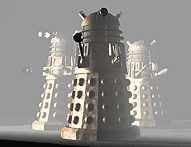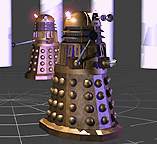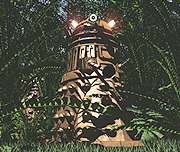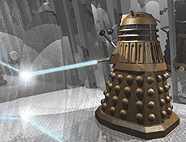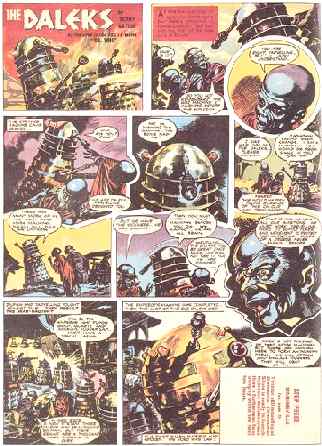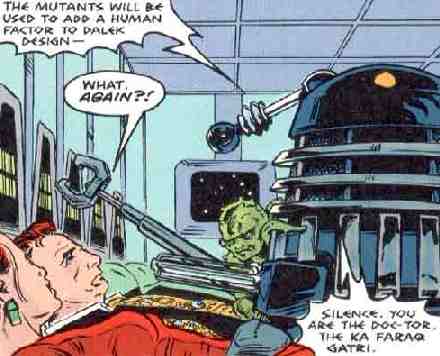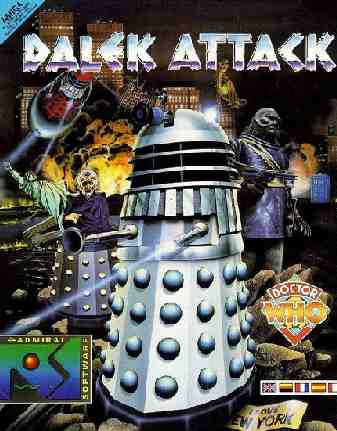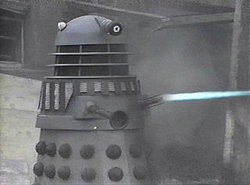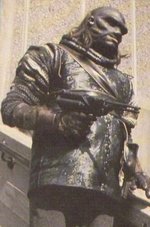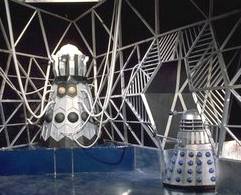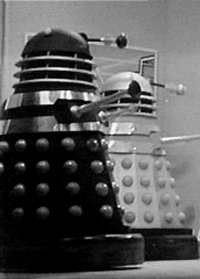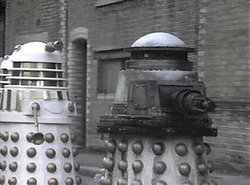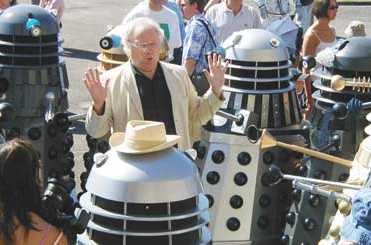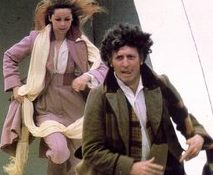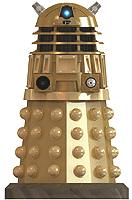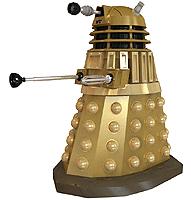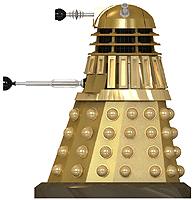|
THE DALEKS - FILMS and TV
|
||||||||||||||||||||||||||||||||||||||||||||||||||||||||||||||||||||||||||||||||||||||||||||||||||||||||
|
Daleks originate from the planet Skaro. They are mutations of a humanoid species who, according to some sources, were called Kaleds. They warred with the Thals, another humanoid race on the planet. The war resulted in a mutated species of Kaleds - the Daleks.
The Daleks above are the original models - see The Mind Robber or more
The Daleks (pronounced "DAH-lecks") are a fictional extraterrestrial race of mutants from the British science fiction television series Doctor Who. The mutated descendants of the Kaled people of the planet Skaro, they travel around in tank-like mechanical casings, a ruthless race bent on universal conquest and domination, utterly without pity, compassion or remorse. They are also, collectively, the greatest alien adversaries of the Time Lord known as the Doctor. Their most infamous catchphrase is "EX-TER-MIN-ATE!", with each syllable individually screeched in a frantic electronic voice (download sample). Other common utterances include "I (or WE) OBEY!" to any command given by a superior.
The Daleks were created by writer Terry Nation and BBC designer Raymond Cusick and were first introduced in December 1963 in the second Doctor Who serial. They became an immediate hit with the viewing audience, featuring in many subsequent serials. They have become synonymous with Doctor Who and their behaviour and catchphrases are part of British popular culture.
The word "Dalek" has entered the Oxford English Dictionary and other major dictionaries (the Collins Dictionary defines it rather broadly as "any of a set of fictional robot-like creations that are aggressive, mobile, and produce rasping staccato speech"). It is also a trademark, having first been registered by the BBC in 1964 to protect its lucrative range of Dalek merchandise.
The term is sometimes used in a metaphorical sense to describe people, usually figures in authority, who act like robots unable to break their programming. John Birt, the much maligned ex-Director General of the BBC, was called a "croak-voiced Dalek" by playwright Dennis Potter in August 1993. The Daleks even appeared on a postage stamp celebrating British popular culture in 1999, photographed by Lord Snowdon.
Externally, Daleks resemble man-sized pepper shakers, with a single mechanical eyestalk in a rotating dome, a gunstalk containing a directed energy weapon (or "death ray"), and a telescoping robot arm. Usually, the arm is fitted with a device for manipulation that, to the amusement of generations of viewers, resembles a plunger, but various episodes have shown Daleks whose arms end in a tray, a mechanical claw, or other specialised equipment like flamethrowers. In Dalek, the plunger was used to kill by crushing a human skull. The casings are made of a material that has been called dalekanium.
In the alternate future of Day of the Daleks, dalekanium is an unstable explosive that can penetrate Dalek casings. The two may be the same, or the term may simply be a neologism to describe a product of the Daleks . The lower shell is covered with many hemispherical protrusions or "Dalek bumps". These have been described as being a sensor array but in the episode Dalek they are part of a self-destruct system.
The creatures inside their "travel machines" are depicted as soft and repulsive in appearance, but still vicious even without their mechanical armour. In Resurrection of the Daleks a Dalek creature, separated from its casing, attacks and kills a human soldier. The Doctor has described the Daleks as "little green blobs in bonded polycarbide armour." However, as the creature inside is rarely seen on screen, the misconception that Daleks are wholly mechanical robots exists, a mistake the series itself has made on occasion. The interdependence of biological and mechanical components makes the Daleks a type of cyborg.
The voice of a Dalek is electronic, the Dalek creature having no vocal apparatus as such. Daleks also have a radio communicator built into their shells, and emit an alarm to summon other nearby Daleks if the casing is opened from outside. The Dalek's eyepiece is its most vulnerable spot, and impairing its vision often leads to a blind firing of its weapon.
TV Century 21 - Dalek comic strip
Due to their gliding motion Daleks were notoriously unable to tackle stairs, which made them easy to overcome under the right circumstances. An oft-copied cartoon from Punch pictured a group of Daleks at the foot of a flight of stairs with the caption, "This certainly buggers our plan to conquer the Universe". In a scene from the serial Destiny of the Daleks, the Doctor and companions escape from Dalek pursuers by climbing into a ceiling duct. The Doctor (Tom Baker) calls down, "If you're supposed to be the superior race of the universe, why don't you try climbing after us? Bye bye!" The Daleks generally make up for their lack of mobility with overwhelming firepower. A joke around science fiction conventions went, "Real Daleks don't climb stairs; they level the building."
In The Dalek Invasion of Earth (1964) a Dalek emerges from the waters of the River Thames, indicating that they are amphibious to a degree. Remembrance of the Daleks (1988) showed that they can hover using a sort of limited antigravity — first implied in earlier serials such as The Chase (1965) and Revelation of the Daleks (1985) — but their awkward forms still limit their mobility in tight quarters. Despite this, the Daleks' supposed inability to climb stairs is still frequently referred to for humorous effect by journalists covering the series. The 2005 series episode Dalek also featured a hovering Dalek. In this episode, before hovering, the Dalek said "Elevate" as it would say "Exterminate" before exterminating.
The Daleks were actually operated from inside by short operators who had to manipulate their eyestalks, domes and arms, as well as flashing the lights on their heads in sync with the actors supplying their voices. The Dalek cases were built in two pieces; once an operator stepped into the lower section the top would be lowered onto him. The operators looked out between the circular louvres just beneath the dome that were lined with mesh to conceal their faces.
Unfortunately, as well as being hot and cramped the Dalek casings also muffled external sounds, making it difficult for the operators to hear the director's commands or studio dialogue. The top sections were also too heavy to lift from the inside, which meant that the operators could be trapped in them if the stagehands forgot to let them out.
Early versions of the Daleks were either rolled around on castors or propelled by wheels connected to hand cranks by bicycle chains. Later versions had more efficient wheels and were simply propelled by the operators' feet. Even so, they were so heavy that when going up ramps they often had to be pushed by stagehands out of camera shot. In addition, the difficulty of operating all the prop's parts at once also contributed to the occasionally jerky movements of the Dalek. The latest model of the costume still has a human operator within, but the movement of the dome and eyestalk is now remotely controlled so that the operator can concentrate on the smooth movement of the Dalek and its arms.
The Dalek voice, a staccato delivery, was initially developed by voice actors Peter Hawkins (who had also provided the voice for the popular children's animated series Captain Pugwash) and David Graham, who would vary the pitch and speed of the lines according to the emotion needed. Their voices were further processed electronically by Brian Hodgson at the BBC Radiophonic Workshop. Although the exact sound-processing devices used have varied over the years, the original 1963 effect used EQ to boost the mid-range of the actors voice, then subjected it to ring modulation with a 30Hz sine wave, and the distinctive harsh grating vocal timbre this produced has remained the pattern for all Dalek voices since then. Notable voice actors for the Daleks include Roy Skelton. In the 2005 series, the Dalek voice is provided by Nicholas Briggs, speaking into a microphone connected to a voice modulator. Briggs has also done Dalek and other alien voices for audio plays.
Dalek movie poster 1965
The non-humanoid shape of the Dalek, unlike anything that had been seen on television before, did much to enhance the creatures' sense of menace. With no familiar points of reference, it was a far cry from the traditional "bug-eyed monster" of science fiction that Doctor Who series creator Sydney Newman wanted the show to avoid. The unsettling form of the Daleks, coupled with their alien voices, also made many believe for a while that the props were wholly mechanical and operated by remote control.
Manufacturing the props was also expensive. In scenes where many Daleks had to appear, some of them would be represented by wooden replicas or even (in early black and white episodes) by life-size photographic enlargements. In scenes involving armies of Daleks, the BBC effects team even turned to using commercially-available toy Daleks, manufactured by Louis Marx & Co. Judicious editing techniques also made it look like there were more Dalek props than were actually available.
CONCEPTUAL HISTORY
Terry Nation claimed that he was inspired by watching ballet dancers in long dresses glide as if on wheels. Indeed, for many of the shows, the Daleks were "played" by retired ballet dancers wearing black socks while sitting inside the Dalek. Raymond Cusick claims that after Nation wrote the script, he was given only an hour to come up with the design for the Daleks, and was inspired by a pepper shaker on the table in front of him to do the initial sketches (other sources state that he based it on a man seated in a chair, and only used the pepper shaker to demonstrate how it might move).
Nation also claimed that the name came from a volume of a dictionary or encyclopedia, the spine of which read "Dal - Lek". He later admitted that he had made this up as a reply to a question by a journalist and that anyone who checked out his story would have found him out. The name had in reality simply rolled off his typewriter. Later, Nation was pleasantly surprised to discover that in Serbo-Croatian the word "Dalek" means "far and distant thing".
Nation grew up during World War II, and remembered the fear caused by German bombings. He consciously based the Daleks on the Nazis, conceiving the species as faceless, authoritarian figures dedicated to conquest, domination, and complete conformity. The analogy is most obvious in the Dalek stories penned by Nation, in particular The Dalek Invasion of Earth and Genesis of the Daleks.
Prior to writing the first Dalek serial, Nation was chief scriptwriter for comedian Tony Hancock. The two fell out and Nation was fired. According to various sources, including Cliff Goodwin's biography of Hancock, the comedian claimed that during one of their last meetings he had speculated on how nuclear warfare might reduce humans to such a helpless state that they would have to be plugged into robot-like casings to stay alive. Allegedly, when Hancock saw the Daleks he shouted at the screen, "That bloody Nation — he's stolen my robots!"
The first Dalek serial is called, variously, The Survivors (the pre-production title), The Mutants (its official title at the time of production and broadcast, later taken by a second, unrelated Doctor Who story), Beyond the Sun, The Dead Planet, or simply The Daleks. The reason for the multiple titles is that in the show's early years each individual episode had a different name and overall story titles were used only by the production office. Subsequently, several different overall story titles were circulated by fandom without access to the correct records. See: Doctor Who story title controversy.
The instant appeal of the Daleks took the BBC off guard, and transformed Doctor Who from a Saturday tea-time children's educational programme to a must-watch national phenomenon. Children were alternately frightened and fascinated by the completely alien look of the monsters, and the Doctor Who production office was inundated by letters and calls asking about the creatures. Newspaper articles focused more attention on the series and the Daleks, enhancing their popularity further.
Despite the Daleks' popularity, however, they were forever associated with Doctor Who. Nation, who jointly owned the intellectual property rights to the Daleks with the BBC, therefore had the problem of owning a money-making concept that proved nearly impossible to sell to anyone else and was dependent on the BBC wanting to produce stories featuring the creatures. Indeed, several attempts to market the Daleks outside of Doctor Who were unsuccessful. The sums of money required to pay Nation for the use of the Daleks also explained why their appearances in the programme were rare in later years. Since Nation's death in 1997, his share of the rights now belong to his estate and are administered by his former agent, Tim Hancock.
SHOW HISTORY
As is common in long-running series whose backstories are not mapped out and which are also the product of many different writers over the course of years, Dalek history has seen many retroactive changes and these have caused some continuity problems. When the Daleks first appeared in The Daleks (1963), they were the product of a brief nuclear war between the Dal and Thal races. However, in 1975, Terry Nation revised the Daleks' origins in the serial Genesis of the Daleks, where the Dals were now called Kaleds (an anagram of Dalek), and the Dalek design was attributed to one man, the crippled Kaled chief scientist and evil genius Davros. Also, instead of a short nuclear exchange, the Kaled-Thal war was portrayed as a generations-long war of attrition, fought with nuclear, biological and chemical weapons. The resulting mutations from the fallout were accelerated by Davros and placed in tank-like "travel machines" whose design was based on his own life-support chair.
Genesis of the Daleks marked a new era for the species, with most of their previous history either forgotten or barely referred to again. Future stories, which followed a rough story arc, would also focus more on Davros, much to the dissatisfaction of some fans who felt that the Daleks should take centre stage, rather than becoming mere minions of their creator.
Davros made his last televised appearance in the serial Remembrance of the Daleks (1988). Remembrance of the Daleks also marked the last on-screen appearance of the Daleks in the context of the programme until 2005, save for charity specials like Doctor Who and the Curse of Fatal Death and the use of Dalek voices in the Doctor Who television movie in 1996.
The Daleks returned in the 2005 series. Dalek, written by Rob Shearman, the sixth episode of the new series, was broadcast on BBC One on 30 April, 2005. The new Dalek exhibited abilities not seen before, including a swivelling mid-section that allowed it a 360-degree field of fire and a force field that dissolved bullets before they struck it. In addition to the ability to fly, it was also able to regenerate itself by means of absorbing electrical power and the DNA of a time traveller. The "plunger" manipulator arm was also able to crush a man's skull in addition to the technology interfacing abilities shown by earlier models. A more sophisticated model of the Dalek mutant was also shown. This Dalek was apparently the sole survivor of a Time War that had destroyed both the Daleks and the Time Lords.
The two-part 2005 series finale, comprising Bad Wolf and The Parting of the Ways saw the return of the Dalek Emperor, who had also survived the Time War and had rebuilt the Dalek race. This Emperor came to see itself as a god, and built its new society around the Daleks' worship of itself. At the end of the story, the Daleks and their fleet were reduced to atoms.
The production team has stated that the Daleks will face the Tenth Doctor at some point, but not in the 2006 series.
Culture
Daleks have little to no individual personalities and a strict command structure, conditioned to obey superior orders without question. Ultimately, the most fundamental feature of Dalek culture and psychology is an unquestioned belief in the superiority of the Daleks. Other species are either to be exterminated immediately, or enslaved and then exterminated later once they are no longer necessary. The default directive of a Dalek is to destroy all non-Dalek lifeforms.
This belief is thought to be the reason why Daleks have never significantly modified their mechanical shell's designs to overcome its obvious physical limitations; any such modification would deviate from the Dalek ideal, and therefore must be inferior and deserving of extermination. The schism between the Renegade and Imperial Daleks is a prime example of this, with each faction considering the other to be a perversion despite the relatively minor differences between them. It also means, however, that Daleks are intolerant of such "contamination" even within themselves, as shown in Dalek and in the Big Finish Productions audio play The Mutant Phase.
Another offshoot of this superiority complex is their complete ruthlessness and lack of compassion. It is because of this that it is nearly impossible to negotiate or reason with a Dalek and it is this single-mindedness that makes them so dangerous and not to be underestimated. However, their reliance on logic and machinery is also a weakness that they recognize. As a result, they also make use of non-Dalek species to compensate for these shortcomings (see Dalek agents).
As noted above, in The Parting of the Ways, the Daleks that were resurrected through the manipulation and mutation of human genetic material by the Dalek Emperor were religious fanatics that worshiped the Emperor as their god.
Although the Daleks are well known for their disregard of due process, there have been two occasions on which they have taken enemies back to Skaro for a "trial" rather than killing them on the spot; the first was their creator Davros in Revelation of the Daleks, and the second was the renegade Time Lord known as the Master in the Doctor Who television movie. Neither trial occurred on-screen, so it is not clear what was actually involved. The Master's trial presumably took place before the destruction of Skaro. The reasons for the Master's trial, and why the Doctor would be asked to retrieve the Master's remains, have never been explained on screen.
The spin-off novels contain several (tongue-in-cheek) mentions of Dalek poetry (and an anecdote about an opera based thereupon, which was lost to posterity when the entire cast was exterminated on opening night). Two stanzas are given in the novel The Also People by Ben Aaronovitch. Some of the more elaborate Dalek battlecries have an almost poetic quality about them (for example, "Seek and Locate! Locate and Destroy! Destroy and Rejoice!" from the televised story The Chase). In an alternate reality portrayed in Big Finish Productions audio adventure The Time of the Daleks, the Daleks show a fondness for the works of Shakespeare.
Due to their frequent defeats by the Doctor, he has become a sort of bogeyman in Dalek culture. They have standing orders to capture or exterminate the Doctor on sight, and are occasionally able to identify him despite his regenerations. This is probably not an innate ability, but rather because of good record keeping. In the comic strips and novels the Daleks know the Doctor as the Ka Faraq Gatri, ("The Bringer of Darkness" or "Destroyer of Worlds") (this was first established in the novelisation of Remembrance of the Daleks by Ben Aaronovitch). In The Parting of the Ways, the Doctor claims that the Daleks call him "The Oncoming Storm" — this name was used by the Draconians to refer to the Doctor in the Virgin New Adventures novel Love and War by Paul Cornell.
The Doctor, in turn, has grown to be almost monomaniacal in his belief that the Daleks are completely evil and unworthy of trust or compassion. This contrasts with some of the Doctor's earlier dealings with the Daleks, for example the Second Doctor's attempt to instil a "human factor" in Daleks in The Evil of the Daleks and the Fourth Doctor's hesitation when presented with the opportunity to destroy the Daleks at the point of their creation in Genesis of the Daleks. It was his conviction of the irredeemability of the Daleks that motivated a venomous outburst by the Doctor in Dalek, leading the lone mutant in that episode to observe that the Doctor "would make a good Dalek."
Other appearances
Two Doctor Who movies starring Peter Cushing featured the Daleks as the main villains: Dr. Who and the Daleks, and Daleks - Invasion Earth 2150 AD, based on the television serials The Daleks and The Dalek Invasion of Earth, respectively. However, the movies were not straight remakes. Cushing's Doctor is not an alien, but a human inventor, and is literally named "Doctor Who." The movies used brand new Dalek props, based closely on the original design but with a wider range of colours. Originally, the movie Daleks were supposed to shoot jets of flame, but this was thought to be too graphic for children, so their weapons emitted jets of deadly vapour instead.
Nation also authorised the publication of the comic strip The Daleks in the comic TV Century 21. The one-page strip (written by David Whitaker but credited to Nation) featured the Daleks as protagonists and "heroes", and continued for two years, from their creation of the mechanised Daleks by the humanoid Dalek scientist Yarvelling to their eventual discovery in the ruins of a crashed space-liner of the co-ordinates for Earth, which they proposed to invade. Although much of the material in these strips directly contradicted what was shown on television later, some concepts like the Daleks using humanoid duplicates and the design of the Dalek Emperor did show up later on in the programme. In 1994, the UK arm of Marvel Comics reprinted all the TV 21 strips in a collected edition titled The Dalek Chronicles.
Marvel UK was publishing Doctor Who Magazine at the time, which included comic strip stories in its pages. Aside from meeting up with the Doctor in them, the DWM strips also introduced a new nemesis for the Daleks, the Dalek Killer named Abslom Daak. Daak was a convicted criminal in the 25th century who was given the choice between execution and being sent on a suicide mission against the Daleks. He chose the latter and, when the woman he loved was killed by the Daleks, made it his life's purpose to kill every Dalek he came across.
The Daleks' popularity extended to books, stage shows and television programmes. Daleks have been the subject of many parodies, including Spike Milligan's "Pakistani Dalek" sketch, and Victor Lewis-Smith's gay Daleks. To an extent Doctor Who itself has also parodied the Daleks from time to time. In 2002, BBC Worldwide published The Dalek Survival Guide, a parody of The Worst-Case Scenario Survival Handbooks. The Daleks have also appeared in the Dalek Empire series of audio plays by Big Finish Productions, of which three mini-series of 4 CDs each have so far been produced and saw the return of the original Dalek Emperor. They have also returned to bedevil the Doctor in Big Finish's Doctor Who line of audio plays.
In the 2003 film Looney Tunes: Back In Action, two Cushing movie-style Daleks made a cameo appearance in the "Area 52" segment amidst many famous "old-time" movie monsters. A Dalek also appears (along with Robby the Robot and the Lost in Space robot) in a 2005 television advertisement for the Australian ANZ Bank. In the Red Dwarf A-Z (a collection of popular Red Dwarf gags, with commentaries by famous fans and the cast and crew), two Daleks are shown (in the Exterminate section, of course), arguing that all Earth television is human propaganda, and the works more commonly attributed to William Shakespeare and Ludwig van Beethoven were actually written by Daleks. After this one of them begins talking about past episodes of Red Dwarf, and is promptly exterminated for the crime of "not behaving like a true Dalek."
Merchandising
The BBC approached Roger Tuckwell, an Australian entrepeneur who was handling product merchandising for other BBC shows, and asked him to do the same for the Daleks and Doctor Who. Tuckwell created a glossy sales brochure that sparked off a Dalek craze, dubbed "Dalekmania" by the press, which peaked around the time The Chase aired in 1965.
The first Dalek toys from Louis Marx & Co. appeared that year, along with toys of the Mechanoids (robotic foes of the Daleks introduced in the same serials). The Mechanoids were created with the expectation that they would become as popular as Daleks, but they were not as successful. Other unsuccessful BBC attempts to create a "replacement" for the Daleks, or at least duplicate their popularity included the Voord (The Keys of Marinus), the Krotons (The Krotons) and the Quarks (The Dominators). Also unsuccessful were Dalek toys made of rubber.
At the height of the Daleks' popularity, apart from toy replicas, there were also Dalek construction kits, Dalek board games and activity sets, Dalek slide projectors for children and even Dalek playsuits made from PVC. There were collectible cards, stickers, toy guns, music singles, punching bags and many other items. Between 1963 and 1965, the BBC published three annuals with short stories and comic strips featuring the Daleks, written by Whitaker and Nation. The Dalek Annual was revived in 1976 and 1977, with stories and selected reprints from the TV 21 comic strip.
In the 1970s, Palitoy released a Talking Dalek which could utter standard Dalek phrases such as "You will obey!" and "Exterminate!" Later, model kits of other Dalek-related characters like Davros, the Supreme Dalek and Gold Daleks were also released. In 2001 a new range of talking Daleks were produced, along with a talking Cyberman and a talking Davros.
The Daleks have featured in computer games since the 1980s, beginning with an unlicensed modification of the Robots game called Daleks. However, the game uses Daleks only as generic monsters, with no Dalek-specific features. Licensed Doctor Who games featuring Daleks include 1984's The Key to Time, a text adventure game for the ZX Spectrum. Daleks also appeared in minor roles or as thinly disguised versions in other, minor games throughout the 80s, but did not feature as central adversaries in a licensed game until 1992, when Admiral Software published Dalek Attack. The game allowed the player to play various Doctors or companions, running them through several environments to defeat the Daleks. In 1998 the BBC released a Doctor Who screensaver done in Macromedia Shockwave which had a built-in minigame, where the player controlled K-9 battling the Daleks through seven increasingly difficult levels.
At present, there are a few unauthorised Dalek games that can be played online, such as the Java applet game Daleks! a Macromedia Flash game, Daleks — Dissolution Earth, and a modification for Half-Life, Dalek Unbidden. Conversely, an authorised online game is The Last Dalek, a Flash game created by New Media Collective for the BBC. It is based on the 2005 episode and can be played at the official BBC Doctor Who website.
DALEK VARIANTS
This article discusses the various variant models of the fictional alien race known as the Daleks in the long-running BBC science fiction television series Doctor Who.
Externally, Daleks resemble overgrown pepper shakers, with a single mechanical eyestalk in a rotating dome, a gunstalk containing a directed energy weapon (or "death ray"), and a telescoping robot arm. Usually, the arm is fitted with a device for manipulation that, to the amusement of generations of viewers, resembles a plunger, but various episodes have shown Daleks whose arms end in a tray, a mechanical claw, or other specialised equipment. The casings are made of a material that has been called dalekanium. The lower shell is covered with many hemispherical protrusions or "Dalek bumps". These have been variously described as some kind of sensor array, but were also seen in the episode Dalek to be part of a self-destruct system. The creatures inside their "travel machines" are depicted as soft and repulsive in appearance, but still vicious even without their mechanical armour.
Although the general appearance of the Daleks has remained the same, the colours and some details of the model have evolved over time.
Standard Dalek
Renegade Dalek firing its weapon - Remembrance of the Daleks
When they first appeared in the 1963 serial, The Daleks, the standard Dalek models sported a silver band along their chest areas, but their mobility was limited to metal walkways in the Dalek City on Skaro, being powered by static electricity. The concept of a "glass Dalek" also appeared in Terry Nation's original story for The Daleks, but due to budgetary considerations did not appear in the serial. It was, however, mentioned in the David Whitaker novelisation. In 1964's The Dalek Invasion of Earth, the size of the base of the Dalek was expanded, and radio dishes were mounted on their backs. These Daleks were more mobile, but still relied on external transmitted power, and were disabled when those transmitters were destroyed. In The Chase (1965), the Daleks were further modified by including what was termed a solar panel array, consisting of wiring and metal slats.
The Daleks of the 1960s serials were mainly silver coloured with blue Dalek "bumps". In The Evil of the Daleks (1967), certain Daleks had black domes. Also, the dishes on their backs had vanished, so presumbly they now had independent motive power systems. In the movies based on the first two Dalek serials, Dr. Who and the Daleks and Daleks - Invasion Earth 2150 AD, the Daleks had larger bases as well as larger, jam-jar shaped ear-bulbs, and were painted in a variety of bright colours.
When the Daleks returned to the series in 1972's Day of the Daleks, the Daleks adopted a grey colour scheme, with the Dalek commander being painted gold. By the time of Death to the Daleks (1974), the Daleks returned to a silver colour scheme with black bumps, but once again reverted to greys in Genesis of the Daleks (1975). In Remembrance of the Daleks (1988) the standard grey-black Daleks were part of the Renegade Dalek faction, with the dominant Imperial Daleks sporting a white-gold colour scheme.
The Daleks returned to the series in the 2005 episode Dalek, with a lone Dalek that had somehow survived the Time War which had resulted in the mutual annihilation of both the Daleks and the Time Lords. There were no major alterations to the Dalek design, except for an expanded base and an all over metallic brass finish, similar to the gold Dalek commander of Day of the Daleks. The ear-bulbs also resembled the movie versions. The Dalek design also exhibited abilities not seen before, including a swivelling mid-section that allowed the Dalek a 360-degree field of fire, and a force field that dissolved bullets before they struck it. In addition to the ability to fly, it was also able to regenerate itself by means of absorbing electrical power and the DNA of a time-traveler. The "plunger" manipulator arm was also able to crush a man's skull in addition to the technology interfacing abilities shown by earlier models.
There are unconfirmed rumours of a more radical redesign for the Daleks that may appear in a later story, but when an army of Daleks appeared in The Parting of the Ways, they featured no changes in design from the one seen in Dalek.
Ogron - Day of the Daleks
Dalek agents
Despite their penchant for racial purity, the Daleks are not adverse to using other species in subordinate roles. They routinely enslave planetary populations, putting them in labour camps and using them as operatives, willing or otherwise. In The Dalek Invasion of Earth they converted selected humans into Robomen overseers, using oversized mind-control helmets. However, these Robomen were mentally unstable and eventually went insane, then turned suicidal. By the time of Remembrance of the Daleks, the control device had been refined and reduced to the size of a microchip implanted behind the subject's ear which could also shut the agent down when they were in danger of being compromised. In the alternate future of Day of the Daleks humans who willingly served the Daleks supervised slave labour.
The Daleks also use mercenaries. In Day of the Daleks and Frontier in Space (1973), the Daleks used Ogrons to police their slaves and as foot soldiers. In 1984's Resurrection of the Daleks, the Daleks used human mercenaries as Dalek troopers (who wore helmets resembling the domed head and eye-stalk of a Dalek) as well as human duplicates known as Dalek Agents.
Dalek battle computers were mentioned in 1979's Destiny of the Daleks. It was their completely logical nature that caused the centuries-long stalemate in the war with the android Movellans. As a result, the Daleks decided to harness human creativity by using them as part of their battle computers, as seen in Remembrance of the Daleks. In that serial, the battle computer was a brainwashed human child sitting in a Dalek-styled chair and wearing a helmet similar to that of the Dalek troopers. The child was also capable of attacking with bolts of energy emanating from her hands, although the Dalek control (and presumably, the offensive capability) finished when the Dalek Supreme on Earth was destroyed.
Dalek Emperor from The Evil of the Daleks
Dalek Emperor
Four different incarnations of the Emperor Dalek are known, three seen on the television series, and one in the TV21 comic strip (a squat, golden Dalek with an enormous head-section). The first seen on screen was an enormous immobile conical shell plugged into a corner of the control room in the Dalek City on Skaro, the second being Davros in a Dalek casing very similar to the TV21 comic version of the Emperor and the third a visible Dalek mutant in a tank surrounded by a giant Dalek head and armour. It is unclear whether any these are the same Dalek, or up to four different Daleks.
The Dalek Emperor was first introduced in the TV21 comic strip The Daleks, reproduced in collective format as the Dalek Chronicles. According to this comic strip version of events, the Emperor was originally a standard Dalek, one of those created by the blue-skinned humanoid Dalek scientist Yarvelling. After the nuclear war that devastated Skaro, it persuaded Yarvelling to build more Dalek casings for their mutated descendants. Before the last of the humanoid Daleks died, a special casing was build for the Emperor, slightly shorter than the other Daleks, with a disproportionately large spheroid head section and in gold rather than grey. This origin story is completely different from that portrayed on television in Genesis of the Daleks.
The Emperor first appeared on television in The Evil of the Daleks (by David Whitaker, who also wrote most of the comic strips) where it was the immobile shell described above. The novelisation of Evil, (adapted from Whitaker's scripts by a different writer) several years later, stated that this Emperor had originally been one of the Daleks who had tried to exterminate their creator Davros in Genesis of the Daleks. In Remembrance of the Daleks, Davros appeared to be greatly deteriorated and apparently reduced to a head and torso. He was contained in a customised Dalek casing similar to that seen in the comic strips, and was referred to as the Emperor (of the Imperial Dalek faction).
The Emperor features in the finale of the 2005 series The Parting of the Ways, its ship having barely survived the Time War. After its ship fell through time, it went into seclusion and went on to rebuild a new race of Daleks. A Dalek Emperor also appears in the Dalek Empire series of audio plays by Big Finish Productions.
Black Dalek from The Dalek Invasion of Earth
Supreme Dalek
Also known as the Dalek Supreme, the type of Dalek originally simply designated as a Black Dalek and later identified with the Dalek Supreme served in the role of an elite or commander Dalek. In The Dalek Invasion of Earth, a Black Dalek is seen directing the Bedfordshire operation. It had a terrifying pet called the Slyther which it used to let roam free around the mines at night killing those it found. A Dalek Supreme also led the Daleks in The Daleks' Master Plan.
The Black Dalek was replaced by the Dalek Emperor in The Evil of the Daleks, which used black-domed Daleks as lieutenants. During the Third Doctor's era, the Black Dalek as field commander appeared to have been replaced by a Gold Dalek (in Day of the Daleks), but the rank returned and was now positively identified as the Dalek Supreme in Planet of the Daleks (1973). In that serial, a movie-style Dalek in black and gold trim was used to represent a member of the Supreme Council of Daleks, with an eye-stalk that lit up when it was speaking. In Destiny of the Daleks, the Dalek Supreme was briefly mentioned as the supreme commander of the Daleks. A Dalek lieutenant is also seen as an intermediate rank in that serial.
The Dalek Supreme, as a Black Dalek, made further appearances in Resurrection of the Daleks and Remembrance of the Daleks. In the latter serial it was the leader of the Renegade Daleks that opposed the Imperial Daleks commanded by the Dalek Emperor. It ended up as the last surviving Dalek on Earth and destroyed itself.
In the Big Finish Productions series of Dalek Empire audio plays, the rank of Supreme Dalek is equivalent to an Army General, subordinate to the Emperor Dalek on Skaro. John Peel's BBC Books Doctor Who novel War of the Daleks combines the ranks of Dalek Supreme and Emperor Dalek in the form of the "Dalek Prime", a Black Dalek with alternating gold and silver bumps. In the novel, the Dalek Prime is the judge at Davros's trial on Skaro.
Special Weapons Dalek & Imperial Daleks from Remembrance of the Daleks
Imperial Dalek
The Imperial Daleks are a faction of Daleks loyal to their creator, Davros, rather than the Dalek Supreme. They first appeared in Revelation of the Daleks (1985). The Imperial Daleks had white livery with gold bumps, and high-pitched voices. These Daleks were not descended from the original Kaled mutants, being instead made from the modified heads of human corpses infused with the Dalek factor. They were destroyed along with Davros's laboratory in the Tranquil Repose funeral home on Necros by the original Daleks. The glass Dalek also finally made an appearance in Revelation - a prototype Dalek with a transparent casing that revealed the mutated head inside.
In Remembrance Of The Daleks, Davros had somehow escaped whatever fate the Daleks had in store for him and had gained control of Skaro, becoming the Emperor. He recreated the Imperial Daleks by grafting bionic appendages onto the bodies of Kaled mutants. Their casings now had golden eye-stalks and a lozenge shape on the front of their casings, and their gold plungers were slotted to fit into machinery. Imperial Daleks could also hover up a flight of stairs.
A civil war, ostensibly over racial purity, broke out between the original, now Renegade Daleks, and the Imperial Daleks. Although their firepower was weak, Imperial Daleks augmented their battle tactics with the Special Weapons Dalek. It is not clear if any Imperial Daleks survived the conclusion of the serial, as both Skaro and the main Imperial Dalek warfleet were apparently destroyed by the Hand of Omega.
Special Weapons Dalek
The Special Weapons Dalek is a heavily-armoured Imperial Dalek first seen in Remembrance. Unlike a conventional Dalek, the Special Weapons Dalek has no manipulator arm or eye-stalk. Instead, it has an enormous energy cannon mounted on the front of the armoured casing in place of the usual small gunstick and several red squares around the dome in place of the usual eyestalk. Special Weapons Daleks do not appear to be able to speak, but do have massive firepower.
In Remembrance the Special Weapons Dalek's firepower was so great that one shot completely destroyed two conventional Renegade Daleks, leaving only a pair of burn marks, and the armour was sufficient to deflect conventional Dalek energy weapons without suffering any apparent damage. Like the other Imperial Daleks, its livery was white with gold bumps, but with sections of metallic gray armour covering most of the upper portion with much battle scoring. The Special Weapons Dalek was also mentioned in the novel War Of The Daleks.
In Ben Aaronovitch's novelisation of Remembrance it was stated that the enormous power source required for its weapon resulted in high levels of radiation being released and altering the structure of the Dalek's brain, resulting in insanity. It was only used in extreme situations and was unofficially known among the Daleks as the "Abomination."
DALEK INVASION OF EARTH
The Dalek Invasion of Earth is a serial in the British science fiction television series Doctor Who, which originally aired in six weekly parts from November 21 to December 26, 1964.
Synopsis
The First Doctor has brought his companions home to Earth at last, but two hundred years in their future. Trapped in a strangely quiet and deserted London, the travellers discover that Earth has been conquered by their old enemies - the Daleks.
THE PLOT
A man staggers towards the River Thames, wearing ragged clothes and a strange metal helmet. He screams, tearing the straps off the helmet, walks into the river and drowns himself. Near the same spot, the TARDIS materialises, the Doctor surmising from the surroundings that they have landed in London. Ian and Barbara are delighted they have returned home at last, but it is a curiously silent and deserted London. The Doctor is concerned about the decay they see around them and wonders about what year it is, fearing that it is nowhere near Ian and Barbara's time. Susan tries to look over a wall, but slips and twists her ankle, at the same time that the bridge under which the TARDIS has materialised collapses, burying the TARDIS and blocking the travellers' access to it. The Doctor and Ian decide to look around in a nearby warehouse for tools to help unblock the TARDIS door. Barbara remains behind to look after Susan.
Exploring the abandoned warehouse, Ian and the Doctor are unaware they are being watched. From a window, Ian spies Battersea Power Station with its chimneys damaged, while the Doctor finds a calendar marked 2164. Barbara, who went to the river to soak a handkerchief for Susan's ankle, returns to find her gone and a dirty-faced man there instead. The man tells her that they have to get out of there before they get killed, and that Susan has been taken by someone called Tyler. He urges her to follow as the sound of automatic fire is heard in the distance. Meanwhile, in the warehouse, the Doctor and Ian stumble across a corpse, wearing the same strange helmet seen earlier. They also find an electronic receiver attached to the helmet and a whip on the body, and discover that the man has been stabbed to death. They decide to return to the others and spy a flying saucer hovering over the city.
Barbara is still following the man across the ruins of London. Tyler carries Susan down a flight of steps into an empty Underground station as Barbara catches up. Susan and Barbara demand that they find the others, but Tyler says that there is no time. Tyler activates a secret panel and David Campbell emerges from it, telling Tyler that he had a struggle with a Roboman and that they will have to tell Dortmun to change the storehouse. He also reveals that he saw the Doctor and Ian in the warehouse but thought they were enemies. Dortmun, a man in a wheelchair, arrives, and Tyler tells him that a saucer has landed at the heliport, and Dortmun says that this time they will be ready for "them". Dortmun is glad to see Susan and Barbara, as extra sets of hands, especially since Barbara can cook. David goes to find the Doctor and Ian. Dortmun asks him not to be long as they need to go through the attack plans. Tyler takes Susan and Barbara below while Dortmun stays on watch, armed only with a knife.
Ian and the Doctor have arrived back at the TARDIS to find the women gone. Ian finds a poster forbidding the dumping of bodies in the river and muses, "Bring out your dead..." Was there a plague in the city? David spots them from a window but he also sees several Robomen converging on their position. The Doctor and Ian find themselves surrounded, but the Robomen only tell them to stop in flat tones. The two try and run for it, but turn only to see, rising from the Thames, the distinctive form of a Dalek.
The Dalek orders that the Doctor and Ian be brought to the landing area, and warn the Doctor that resistance is useless and that they have already conquered the Earth. In the resistance base, the humans listen to Dalek propaganda broadcasts demanding their surrender. A young woman called Jenny tends to Susan's ankle while Barbara prepares food. Tyler and Dortmun debate about whether they are capable of attacking the Dalek saucer with the numbers they have. Dortmun shows off a new acid bomb that he has created, which he is confident will shatter the Dalek casings. David returns, reporting the capture of the Doctor and Ian. They have been taken to the heliport at Chelsea.
Ian is confused, as they saw the Daleks being destroyed on Skaro. The Doctor explains that Skaro was a million years from the present — what they are witnessing is the middle period of Dalek history. Dalek guards usher the prisoners into the saucer. One human tries to escape and is exterminated. Back in the base, David explains that the Daleks operate on some of their human prisoners and turn them into Robomen, but the transfer operation is unstable and eventually the Robomen go insane and turn suicidal. The saucer is where the transfer takes place. On the saucer, the Doctor and Ian are put in a cell together with another prisoner, Craddock. Ian asks him how the invasion happened. Ten years before, meteorites brought a plague to Earth, splitting the Earth into small communities and unable to resist six months later when the Dalek saucers landed. Some were turned into Robomen, others destroyed or sent to the mining areas in Bedfordshire. Craddock does not know, however, what the Daleks want out of the ground.
The Daleks - new series see The Mind Robber for more like this
The resistance plans the assault. Barbara suggests using the Robomen helmets as a disguise to get them close enough to use Dortmun's bombs. Meanwhile, the Doctor attempts to manipulate a device inside the cell which he suspects to contain a key to the door. However, what he does not realize is that the device is an intelligence test. The Daleks have been observing him remotely, having earlier adjudged him more intelligent that the other humans from his earlier remarks. Solving the lock confirms their assessment, and the Doctor is taken away to be robotised. The Doctor is placed on a transfer table as outside the saucer, the resistance forces gather.
Tyler's attack group arrives, disguised as Robomen and prisoners. Susan, David and Barbara start throwing bombs from a nearby building. Tyler's group enters the saucer to try and free the prisoners while outside the Daleks scramble to mount a defense. Members of the group carry the unconscious Doctor away from the transfer table rush out of the saucer with the prisoners, using the bombs to cover their escape. The bombs, however, are ineffective. Dalek blasts and gunfire mix with the chaos of dying men as they scramble away. In the confusion, Barbara is injured and Ian remains behind on the saucer. Tyler is separated from the Doctor — he tells Dortmun back at the base that he is going to search for survivors of the raid and then leave London. Dortmun wants to go to the Civic Transport Museum, another gathering place, to get supplies so he can continue working on his bombs. Barbara and Jenny agree to go with him.
In the saucer, the Black Dalek relays an order from Supreme Command to destroy London with firebombs. The saucer lifts off, on its way to the mines. Ian emerges from his hiding place, only to bump into a robotised Craddock, who is escorting a prisoner for transfer. Ian struggles with Craddock, who stumbles against the transfer machinery and is electrocuted. The man introduces himself as Larry — he had stolen aboard the saucer in order to hitch a ride to Bedfordshire to find his brother. They get rid of Craddock's body via a disposal chute.
David and Susan hide from Dalek patrols, and listen in horror as the sounds of extermination echo around them. Susan wishes she could just go back to the TARDIS and get out of here, and suggests that she could persuade her grandfather to take David along. David tells her that running away does not solve all problems, and besides, Earth is his planet and he cannot abandon it. Susan thinks about how she has never had a place she could call home or her own identity. David says that someday she will. Suddenly, they hear a noise — Baker, carrying the drugged Doctor. Baker says he will be heading for the Cornish coast, but, just as he leaves the others, he is intercepted and exterminated by a Dalek patrol.
On the streets of London, deserted except for Daleks, Jenny, Barbara and Dortmun avoid the patrols and make it to the museum. There Dortmun finds his notes and determines the fault was not with the bombs but with the dalekanium casings of the Daleks. He comes up with a new formula for the acid bomb, and wants Barbara to take his notes to the Doctor. Barbara tells him he can give it to the Doctor himself, but once she leaves the room, Dortmun leaves his notes behind and goes outside to try the new bombs against the Daleks himself. He calls out defiantly to the Daleks, throwing a bomb at them as they exterminate him. However, the new bomb fails to make an impact. Jenny and Barbara make their escape.
The Doctor begins to get feeling back in his legs. Susan tells him that David suggests heading North to meet with a resistance group there but the Doctor says that he they should try to reach the TARDIS, tetchily observing that Susan seems to trust David's word over his. Susan protests that it is simply because David knows this time better. David returns, saying that there are patrols everywhere, and asks the Doctor for his advice as he is the senior member of the party. Somewhat mollified by the gesture of respect, the Doctor "suggests" to David that they make their way North. Susan is pleased. Hidden in the saucer, Larry tells Ian of his brother Phil's theory that the Daleks want the magnetic core of Earth. The saucer finally lands and the Daleks disembark with their new workers and the Roboman guards. Ian and Larry leave through the disposal chute and make for the nearest tunnel. Back in London, two Robomen place a Dalek firebomb near the Doctor, Susan and David's hiding place, and it begins to tick down.
The Doctor passes out, leaving David and Susan to defuse the firebomb on their own. David uses acid from one of Dortmun's bombs to burn through the casing, and removes the timing mechanism before it can trigger the explosive. David suggests they leave the Doctor behind for the moment while they search for a way through the sewers out of London. Susan does not like the idea of leaving the Doctor alone but David says they have no choice. Meanwhile, Barbara and Jenny fix up a lorry from the museum in preparation to drive up to Bedfordshire. There, Larry and Phil are moving through the countryside, spotting a group of human slaves pulling a carriage of metal parts towards a mine shaft and hearing the sounds of machinery. Trying to get under cover, they meet a man called Wells, who thinks they are escaped workers. He tries to cover for them, however, when a Roboman comes to take them for selection to be robotized. Ian and Larry help Wells when the Roboman attacks him, and knocks the Roboman out. Wells tells them he was here to meet Ashton, a black marketeer. Ian wants to meet Ashton, hoping he has a way to get him back to London. Wells tells Ian that the Daleks have destroyed the city.
Daleks - Longleat exhibition
In London, Barbara and Jenny ride out of the museum in the lorry, past Dortmun's corpse. They run a road block, Barbara crashing the lorry through the Daleks, but their position is reported back to the saucer, which gives orders to intercept them. Jenny and Barbara manage to leap out of the lorry before it is destroyed by the saucer. David and Susan move through the sewers, where they meet Tyler, who warns them of alligators in the sewers. Susan hopes that she will never become as cynical as Tyler, but David says that one day it will be all over and they can rebuild the planet from the start. Susan finds the idea of a fresh start exciting. While exploring, Susan nearly falls into the jaws of an alligator, but Tyler and David manage to rescue her. They climb out of the sewers, Tyler having found the Doctor who has now recovered. In Bedfordshire, Larry and Ian avoid the monstrous Slyther, the pet of the Black Dalek, and while hiding, meet Ashton. Ian asks if Ashton can take him to London, but Ashton refuses unless Ian can pay in gold or other precious metals. Wells arrives, trading jewellery for food, but the Slyther attacks as they are eating. Ashton is killed, while the Slyther approaches Larry and Ian, who are trapped on the edge of a sheer drop.
The two jump into a mining bucket suspended over the pit, and although the Slyther tries to jump after them, Ian hits it with a rock and causes it to fall to its death. Before Ian and Larry can climb out of the bucket, it starts to descend. In London, Robomen pursue the Doctor and his party back into the sewers. Tyler and David lay an ambush, and manage to subdue them. Meanwhile, Jenny and Barbara find a hovel in the countryside with two women, seeking shelter from a storm. The women are left alone by the Daleks because they make clothes for the slave workers in exchange for food. Barbara offers them food in exchange for staying the night. The older woman sends the younger one to deliver clothes, but she has actually gone to bring the Daleks, who capture Jenny and Barbara.
Ian and Larry finally reach the bottom of the shaft, and jump down the last twelve feet before the bucket tips over. Larry injures his knee as he falls, however. As he hides, Ian looks around, puzzled that the mine only seems to be made for shifting rocks and not processing ore. Larry repeats his brother's theory that the Daleks are after the Earth's core. Trying to blend in with a working party, they are confronted by a Roboman — Larry's brother Phil. Larry pleads with Phil, trying to make him remember who he is, but Phil prepares to shoot them. Larry tells Ian to run as Phil shoots, mortally wounding Larry even as Larry strangles him. Both die, with Phil's last word being a strangled, "Larry..." Alarms sound as the workers seize their chance for freedom.
In the countryside, Susan and David share a tender moment around a campfire, kissing before the Doctor and Tyler return. The Doctor has deduced the reasons why the Daleks are here — something deep beneath the Earth, tampering with the forces of creation. Ian makes his way deeper into the mine, noticing Jenny and Barbara, who have joined a working party. Jenny is in despair, but Barbara says they must find the control room, as that would be what the Doctor would do. Ian keeps hidden, but tells Wells to pass word to Barbara that he is here. Barbara tells the Daleks that the rebels are planning an attack, and shows them Dortmun's notes. She asks to speak to someone in authority and they agree to take her to the Black Dalek. Meanwhile, the Daleks report to the Black Dalek that they have almost reached the outer crust of the core. All that remains is to set up and the penetration explosive. Once the core is removed, they will replace it with a power system that will allow the Daleks to pilot the planet anywhere in the universe. Unfortunately, Ian has chosen the penetration device as a hiding place, and it is moving into position to be dropped down the main shaft.
Ian disconnects some wires inside the casing, stopping its descent. The Robomen start pulling it back up the shaft, while Ian manages to open a panel at the bottom of the casing and climb out. A Dalek spots him, however, and severs the rope, causing Ian to slide down the shaft and fall against a door, which knocks him senseless. At that point, Barbara and Jenny are escorted into the Dalek control room. The Black Dalek orders that all humans be moved to the lower galleries to be exterminated in the final blast. The Daleks relay the orders to the Robomen through a microphone, which Barbara notices. The Black Dalek interrogates Barbara and she tries to stall by telling them of an elaborate mutiny that involves Red Indians, the Boston Tea Party, Robert E. Lee and Hannibal, panicking the Daleks momentarily but not enough — she is recaptured when she tries to use the microphone. She and Jenny are immobilized in clamps to await destruction when the bomb explodes.
Outside, the Doctor tells Susan and David to destroy an aerial on the far side of the mine with Dortmun's bombs. He and Tyler will go into the mine itself. Ian regains consciousness outside the lower gallery where the Robomen are hauling timber. When they leave, he puts some of these spars into the bomb shaft, where it stops the progress of the bomb before it can reach the crust. The Daleks are unaware of this, however, and evacuate. The Doctor neutralises the warning system and he and Tyler make their way into the control room, where they free Jenny and Barbara. He explains that David and Susan's mission will immobilize the Daleks. As the Daleks detect the Doctor's presence in the control room, a patrol approaches, but David and Susan succeed and the Daleks stop in their tracks. Barbara and Susan use the microphone to tell the Robomen to turn against the Daleks. Human workers and Robomen break into open revolt and stream out of the mine.
Ian is reunited with the others. From where the bomb has stopped, it will not succeed in penetrating the crust but will still produce a gigantic explosion. As they reach higher ground, the bomb explodes, making the ground around the mine collapse and cause an entirely new phenomenon — a volcanic eruption in England. The Dalek saucer is caught in the upward thrust of the explosion. The invasion is over.
Back in London, the resistance helps the Doctor uncover the TARDIS as the chimes of Big Ben herald a new beginning for mankind. Susan is saddened at the prospect of leaving, and the Doctor seems to sense this. He goes into the TARDIS while Susan goes to say good-bye to David, who tells Ian he wants to work the land, see things grow again. Barbara takes Ian back into the TARDIS so they can leave Susan and David alone. David tells Susan that he loves her and asks to stay and marry him, offering her the place and identity she has been yearning for. Susan admits she loves him too, but she also needs to look after her grandfather, and begs him not to make her choose between them. The Doctor, having heard all this, makes Susan's choice for her. He double-locks the doors of the TARDIS, preventing Susan from entering. He tells Susan through the scanner that she will always be his grandchild, but she is a woman now, and he wants her to have a home; David will take care of her. Saying one last good-bye and saying he will one day return, he makes the TARDIS dematerialise.
Susan looks forlornly around the empty space where the TARDIS used to be, fingering the TARDIS key on the chain around her neck. David reaches his hand out to her and she takes it, dropping the key onto the ground and walking away.
THE DALEKS MASTER PLAN 1965
The Daleks' Master Plan is a serial in the British science fiction televi ion series Doctor Who, which originally aired in twelve weekly parts from November 13, 1965 to January 29, 1966.
SynopsisIn the year 4000, the Daleks launch their plan to conquer the Solar System. The key to this is a traitor at the highest levels of the System's government and a device known as the Time Destructor. The First Doctor and his companions must stop them, but at what cost?
THE PLOT
The TARDIS arrives on the planet Kembel, and the Doctor leaves the TARDIS to try and find medical aid for the wounded Steven, leaving him with the Trojan servant girl Katarina. Meanwhile, two Space Agents, Bret Vyon and the injured Kert Gantry are also on the planet trying to find out what happened to their agent, Marc Cory. Eventually Gantry tells Vyon to go on without him, as he will slow Vyon down. Seconds after Vyon leaves, a Dalek finds Gantry and kills him. Vyon then spots the Doctor leaving the TARDIS, and takes the key from him at gunpoint before knocking him out. Eventually finding the TARDIS, Vyon demands that the occupants take him off the planet, but Katarina barely understands what's going on, much less how to work the ship. Steven then briefly recovers and knocks Vyon out after seeing him threaten Katarina. The Doctor returns and places Vyon in a restraining chair, then goes back outside.
On Earth, Mavic Chen, Guardian of the Solar System, announces to the people that he will be going on a break. However, in reality he is joining the alliance that has been formed by the Daleks, and arrives on the planet soon afterwards.
Seeing Chen's ship arrive, the Doctor returns to the TARDIS, only to find it surrounded by Daleks. Katarina had released Vyon, who cured Steven with some field medicine, and the four meet up soon after just as the Daleks set fire to the jungle, in order to drive out any further intruders. While the alliance prepares for a meeting of its leaders, Chen and another leader, Zephon, watch the jungle burn. Chen goes to the meeting, but Zephon refuses to go with him, saying that he will go when he feels like it. The Doctor and his companions infiltrate the city, and spot Zephon going to the meeting. They knock Zephon out, tie him up, dress the Doctor up in Zephon's large cloak and send him to the meeting while the other three break into Chen's ship, The Spar.
Arriving at the meeting, the other leaders express irritation at the lateness of "Zephon". The meeting begins, and the Dalek Supreme reports that their ultimate weapon, the Time Destructor is now complete. Chen reveals that he has procured a sample of the extremely rare element taranium, necessary for the Time Destructor's operation. Meanwhile the real Zephon has managed to untie himself and sounds the alarm. In the resulting confusion, the Doctor steals the taranium and flees, managing to get to The Spar just in time for take-off. The Daleks blame Zephon for the situation, saying that his tardiness caused the Doctor and companions to find him, but Zephon defends his actions and accuses Chen of arranging to have it stolen back. Chen says that Zephon's accusation is nonsensical and the Daleks concur, concluding that Zephon is the one who's responsible. Zephon tells the Daleks that two of the other leaders will also leave if he does, only for the leaders in question to swear allegiance to the Daleks. Finally, Zephon announces that he is leaving the alliance. He does not get the chance - a Dalek kills him as he goes to leave.
On course for Earth, the Doctor reveals that he found a tape while he was in the jungle. The group plays it back, and it turns out to be from Cory, whose brief statements confirm what they already know. As they near the prison planet Desperus - where convicts are simply left, without having any guards or means of escape - the Daleks use a randomiser to disable the controls of The Spar, and send it crashing down towards the planet below causing minor damage to the ship upon landing. Realising that the impact should have totally destroyed the ship, the four realise that the Daleks want them alive and quickly begin repairing it. Upon seeing the landing, a group of prisoners attempt to get on-board, but the Doctor electrifies the entrance and the prisoners are killed. A Dalek ship arrives, but misjudges its landing and suffers a crippling crash. The Spar manages to take off again, and Katarina goes to check the airlock but finds a convict who managed to get onboard just before take-off, the other prisoners having discharged the electricity in the ship's entrance. The convict, Kirksen holds her at knifepoint and threatens to kill her unless they take him to the nearest planet - Kembel. The group eventually decides to comply, but their decision soon proves irrelevant as Katarina activates the airlock, blowing her and Kirksen into space. Stunned, Steven suggests that she must have done it accidentally, but the Doctor thinks that it was deliberate.
Upon seeing the events, the Daleks remotely destroy the pursuit ship for their failure to land properly, but seem satisfied that the delay caused by the crash will allow Chen enough time to get to Earth and have the trio arrested when they arrive. Arriving on Earth, the three evade detection, and go to see Vyon's old friend, Daxtar. Daxtar initially seems co-operative but the Doctor realises he's allied with Chen when he mentions the Taranium before anyone else does. Vyon quickly kills him, much to the Doctor's annoyance, but there's little time to dwell on this as Chen's security agents, led by Sara Kingdom, arrive. Vyon allows the Doctor and Steven to get away by throwing himself at Kingdom, but she overpowers and kills him. She chases the Doctor and Steven to a laboratory, where they get caught up in a molecular dissemination experiment and are transported to the planet Mira.
Chen pretends that he planned this, and tells the Daleks where to find the Doctor and Steven. On Mira, Kingdom (who turns out to be Vyon's sister) is forced to join forces with the Doctor and Steven as they are attacked by savage invisible creatures. They manage to convince Sara of Chen and the Daleks' true intentions, just as a Dalek ship arrives. The Daleks fend off an attack from the invisible creatures, and demand that the three surrender. Fortunately for the Doctor and his companions more invisible creatures attack, allowing the three to escape and steal the Dalek ship. They try to return to Earth, but the Daleks first take control of the ship remotely, then use a magnetic beam to draw it to Kembel. Realising that they don't have much time, the Doctor decides to build a fake Taranium core, which he can give to the Daleks while keeping the real one. Steven then gets the idea to charge it up with gravitic energy, but in the process encloses himself in a forcefield and is left barely conscious.
Upon landing, the three negotiate with Chen (who has since returned to Kembel) to be allowed to conduct the handover at the TARDIS. The Daleks refuse, but Chen persuades them that they don't have anything to lose, thinking that the Doctor will be unable to stop them after the core has been handed over. The Doctor and Sara return to the TARDIS, while Steven hands over the core. The Daleks try to kill him, but the forcefield manages to protect him, though is exhausted in the process.
After leaving Kembel, the three return to Earth in the 1960s, land outside a Police Station and get themselves arrested, later managing to escape and then ending up on the set of a silent film, causing many problems for the film crew (such as the Doctor being mistaken for a cultural advisor and the lead actress nearly quitting because she thinks the director wants to replace her with Sara) before escaping. Upon their escape they toast Christmas, and the Doctor wishes a happy Christmas to the viewers.
Meanwhile, back on Kembel the fake core is fitted to the Time Destructor which is then tested on another representative, Trantis, who has proven useless to the Daleks. However, there is no effect and the fake core quickly exhausts itself, leaving Trantis totally unharmed. The Daleks accuse Chen of lying about the Taranium, when Chen realises that it was the Doctor that switched the cores. They send a request for a time machine, in order to pursue the Doctor. Trantis is then killed by a Dalek.
The TARDIS briefly lands back on Earth during a cricket match, then landing on a volcanic planet. They have been followed by the Meddling Monk who damages the TARDIS's door lock, then mockingly informs the Doctor and companions that they are stranded on the planet for the rest of their lives. Not to be deterred, the Doctor performs makeshift repairs to the lock, and gets back inside the TARDIS. The Monk is surprised by this, but follows the Doctor to his next destination - Ancient Egypt. The Daleks and Mavic Chen also arrive in this time zone, and begin looking for the Taranium.
Realising that the Monk and someone else has arrived, Steven and Sara go to find out who it is while the Doctor repairs the lock, but are arrested as looters by the guards of the nearby pyramid and accused of being in league with the Daleks, who have killed a number of other guards. While the two make their escape the Monk tries to find the Doctor, but is instead found by Chen who offers him an ultimatum - help them find the Taranium or the Daleks will kill him. Unsurprisingly, the Monk accepts.
While he cannot find the Doctor, he finds Steven and Sara inside a pyramid and is captured by them. They don't get far before being caught by the Daleks and Chen, who demands the taranium. In desperation, the Monk suggests using Steven and Sara as hostages. Chen accepts this, and tells the Daleks that the Doctor will not allow the two to be killed. As the Doctor breaks into the Monk's TARDIS and steals something, Chen announces over a loudspeaker that unless he hands over the Taranium, Sara and Steven will be killed. The Doctor is dismayed, but has little choice but to comply. When he hands over the core, the Daleks try to kill them and the Monk but they all escape, helped by an attack by the Egyptian guards. While the guards disable some of the Daleks, most of them escape and return to their time machine with Chen.
Back in the TARDIS, the Doctor admits that he did not have time to build another fake, and had to hand over the real taranium. But he's stolen the Monk's directional controller - evidenced when the Monk lands on an ice planet and realises that without having any control over the direction of his TARDIS he now has little chance of ever catching the Doctor. The directional control burns itself out almost instantly (due to the Monk's TARDIS being a later model than the Doctor's), but it's enough to get them back to Kembel. The three leave the TARDIS, but Sara and Steven lose the Doctor in the jungle and proceed to the city alone. Upon arrival they find the Dalek city deserted, and the alliance leaders imprisoned. They agree to turn on the Daleks, and in exchange are released from the prison cell. They take off in their ships - apart from Chen, who is apparently killed when The Spar explodes just after take-off.
Searching the jungle, they find the entrance to a second, underground city which the Daleks are now currently using. As they prepare to enter, Chen returns, having faked his death and takes the two prisoner. He leads them into the underground city and into the control room in grandiose fashion. Thinking that he was still imprisoned in the first city, the Dalek leader announces that their alliance is over. Chen refuses to accept this, and believes that he is actually the leader of the alliance. He tries to kill the Dalek leader, but his blast simply diffuses off the Dalek's shield. The Dalek orders Chen taken outside and killed, causing Chen to flee boasting that he is immortal. He's quickly proven wrong when a Dalek patrol corners him and guns him down.
Taking advantage of the distraction, the Doctor enters the control room and activates the Time Destructor. The Daleks return, but are powerless to do anything due to the danger of the Doctor increasing the Destructor's power. He orders Sara and Steven back to the TARDIS, but Sara refuses to go. The two flee with the Time Destructor through the jungle, which rapidly begins to deteriorate and die. The Daleks pursue them, but seem immune from the effects. The Doctor and Sara reach the TARDIS but have been aged massively by the Destructor. The two collapse, and Sara disintegrates. Steven rushes outside and tries to deactivate the Destructor, but cannot do anything. As he begins to rapidly age, he tries to help the Doctor, but is ordered to get back into the TARDIS. Fortunately, when trying to deactivate the destructor he managed to reverse it, thus causing the two to revert to approximately their previous ages. The pursuing Daleks try to destroy the Destructor with their weapons but instead cause it to run uncontrollably fast, destroying the Daleks and reducing the planet to a lifeless, barely habitable wasteland.
The Doctor and Steven emerge from the TARDIS some time later, the Destructor having burnt itself out. "What a terrible waste..." mutters the Doctor, referring to the death and destruction that has taken place.
THE DEATH OF THE DALEKS 1974
THE DESTINY OF THE DALEKS 1979
Destiny of the Daleks is a serial in the British science fiction television series Doctor Who, which was first broadcast in two weekly parts from September 1 to September 22, 1979. The story introduces Lalla Ward as the newly-regenerated Romana.
Synopsis
The TARDIS lands the Fourth Doctor and Romana on a strangely familiar planet. There, they meet the android Movellans, who are locked in a war with the Daleks. The planet is Skaro, and in a bunker sits an enemy long thought dead — Davros, creator of the Daleks.
THE PLOT
The Doctor, following the preceding events of The Armageddon Factor, has installed a "Randomiser" onto the TARDIS, to elude the Black Guardian, and is repairing K-9. After marvelling at K-9's impressive and complex "brain" (in fact a complicated electrical circuit), he notices that K-9 is, unusually for a robot, coughing. The Doctor establishes that K-9 has a form of laryngitis (which is, as the Doctor points out, pointless as a robot would have no use for such an affliction). He calls for Romana, and is surprised when Princess Astra from the preceding adventure emerges (in full regal regalia). However this is not Astra at all: this is Romana, and she has regenerated into a form she has modelled on the princess.
The Doctor, however, is not impressed and tries to disuade her from "going around wearing copies of bodies", but to no avail. He then urges Romana to try another body, to which she agrees and walks out of sight to do just that. When she returns she appears to be a dwarfish, purple-faced (or face-painted) female, who retains Romana's voice. Unhappy with the height, she is told by the Doctor to "lengthen it", and she leaves to try again. When she returns, she resembles a drag queen; and the Doctor (possibly slightly disturbed by this) gives a polite "No thank you, not today." Romana then tries an extremely tall, willowy and serious=looking female form, which the Doctor then dismisses as being too tall. Her then advise her to wear something more sensible and stylish; and she returns in a costume resembling his own (by which he is delighted). He soon realises that she once again resembles Astra; but he gives up, realising that her mind is made up, and agrees to let her resemble Astra. The TARDIS then lands...
The TARDIS has landed on a seemingly very rocky planet which has breathable air and hospitable conditions; but has dangerously high levels of radioactivity. He gives her tablets to combat the radiation and a beeper-like device to inform her when she must take her pills. They exit the TARDIS and establish that this a rocky planet with seismic disturbances. They come across a spaceship which half-buries itself into the ground in a valley; and just as the Doctor and Romana are about to investigate, they witness what appear to be savages burying one of their dead (although this deceased fellow is not all he appears: he is from the planet Kantra, a tropical paradise; so he should not have been here in theory. The pair follow the "savages" inside a ruin, but whilst exploring this ruin a column falls upon the Doctor, and it is too heavy for Romana to lift alone. She agrees to reassemble the literally "brainless" K-9 and get him to assist in lifting of the debris. She sets off, but finds the TARDIS half-buried in rubble (and, unbeknownst to her, she is being followed). Realising that she cannot reach K-9, she starts to turn back.
Meanwhile, the Doctor is quite happily reading a book ("Origins of the Universe" by Oolon Colluphid), and regretting that he forgot to remind Romana to take her anti-radiation pills, when a troup of silver-haired humanoids appear and point their weapons at him. He seems to try to charm them, but it does not seem to be working.
Romana returns to the ruin, to find that the Doctor has vanished. As she turns to leave, she finds the man who has been following her blocking her path. She backs away, only to fall down a rubble chute, and she loses consciousness. The man then prepares to climb down and help her, but before he can do so she recovers consciousness and hears a noise coming from one of the walls that resembles drilling. She backs awaty from the wall; when suddenly a pair of Daleks burst through the wall: "Do not move. Do not move. Do not move. Do not move. Do not move. Do not move. You are our prisoner - do not move. You are our prisoner!" The Daleks threaten to exterminate Romana if she does not comply with their instructions explicitly, and then command Romana to come with them. (The man, meanwhile, has seen the whole thing.)
Tom Baker - Destiny of the Daleks
Meanwhile, the Doctor is thanking the Movellans (as these silver-haired humanoids are called) for helping him, and he remarks at their strength. He then asks their commander Sharrel where he is, and Sharrel replies that the planet is known as D-5-Gamma-Z-Alpha. The Doctor then enquires to its name, he is astonished hear that it is Skaro, and that the Movellans are here to wage war against the Daleks. Romana, meanwhile, is being interrogated by the Daleks. After they learn that she is of no threat to them, the Daleks command Romana to work at one of their drilling sites.
The Doctor and the Movellans meet with the man who has been follwing him and Romana; he identifies himself as Starship Engineer Tyssan, who was captured by the Daleks two years ago. He collapses after revealing that the Daleks have used him during a drilling operation for a search operation. He soon comes around, and says he does not know what the Daleks are looking for. He then tells the Doctor about what has happened to Romana, and they set out to rescue her.
In the meantime Romana meets with some other workers, with whom she discusses the Daleks' hatred for humanoids, and she learns that she is getting weaker as a result of radiation sickness. She learns that the only way out is to die; when within minutes she seems to die. Her fellow workers remove her body. The Doctor, Tyssan and the Movellans Lan and Agella are shocked to find Romana's grave. As the Doctor frantically tries to dig her out, she appears and explained that she feigned death to escape, and that at school she was taught how to stop her hearts. They then head into the Dalek headquarters. There they establish that they are searching for something on a floor that they cannot access, and they (as silently as possible) make their way to this floor. There they discover Davros, the creator and leader of the Daleks (having been exterminated at the end of Genesis of the Daleks). Something gives way up above, and part of the ceiling collapses onto Agella. Whilst the party is destracted by this, Davros starts to stir: his fingers move, his central, artificial eye lights up - and Davros lives...
The Doctor finds Davros and takes him into a blocked-off room in the old Dalek city. He lets Romana, Tyssan and Lan escape out of the window, and the return to the Movellan ship. The two geniuses talk about the Daleks' "accomplishments": whilst the Doctor comments on the countless lives the Daleks have ruined, Davros replies that this is only the beginnning - the Daleks have only just begun their conquest of the cosmos. The Daleks find them both, and proceed to exterminate their prisoners until the Doctor complies. the Doctor then threatens to kill Davros with a makeshift explosive he has just concocted. He then orders the Daleks to free all their prisoners, and to let him escape. The Daleks say that these conditions are unacceptable and illogical (and therefore, to a Dalek, impossible); and that the exterminations would continue. However Davros makes them see that the Doctor's logic is "impaired by irrational sentiment". The Daleks then comply, and the Doctor attaches the explosive to Davros' chair, and tells him that it will detonate when he uses his sonic screwdriver. He then escapes. Davros frantically orders the Daleks to remove the explosive; which they do (although the Doctor detonates and the explosion seems to take a Dalek with it). Davros then vows to make the Daleks invincible, and the supreme power of the universe. (However, we notice that Agella is not dead; and that she will return and report all she has just heard to her fellow Movellans.)
Romana reaches the Movellan spaceship; but learns that the Movellans are not as altruistic as they appear; and Agella uses her weapon on her, which knocks her out. The Movellans than test out their nova device: a weapon which changes air molecules so that a planet's atmosphere becomes flammable and can be set alight - killing all lifeforms.
The Doctor meets up with Tyssan and they both find a Movellan scout. The Doctor deactivates her by removing the power pack/controlling circuit on her belt and reveals that the Movellans are, in fact, robots. He finds that the unconscious Romana has been attached to the nova device (sealed inside an airtight container). He sends Tyssan away and tries to open the container, as the timer is ticking down. Just as the timer approaches zero, the Doctor is knocked out by one of the Movellans' weapons. However, the nova device was revealed to be a "dud" - a decoy used to lure the Doctor.
The Doctor learns that the Daleks and Movellans have been in a stalemate for over two centuries, and that both sides' battle computers have been calculating the best strategy and precise moment at which to attack - so far not a single shot has been fired. The Daleks want Davros to help them gain an advantage. The Movellans want the Doctor to do the same for them, which the Doctor refuses to do. Davros, on the other hand, is all too eager to give the Daleks the upper hand; and he orders then to make a suicide bombing attack on the Movellan craft. However, the Doctor tricks Davros into destroying his suicide Daleks; and then takes Davros into the custody of the former slave workers. He shall be placed in cryogenic suspension and taken to Earth to stand trial for his crimes. The Doctor and Romana leave; remarking on the fact that whoever makes mistakes often wins (as the Doctor knows only too well).
REMEMBERANCE OF THE DALEKS 1988
Remembrance of the Daleks is a serial in the British science fiction television series Doctor Who, which was first broadcast in four weekly parts from October 5 to October 26, 1988. The serial opened the 25th anniversary year of the series, and revisited the locations of the very first Doctor Who episode, An Unearthly Child, specifically the Coal Hill School and the junkyard at 76 Totter's Lane.
Synopsis
The Seventh Doctor returns to London in 1963 to deal with some loose ends involving an ancient and powerful Time Lord device. Things, however, get messy very quickly when two competing factions of Daleks are also after the same thing
Plot
The Seventh Doctor and Ace land the TARDIS in London, 1963, where the Doctor has unfinished business: The Hand of Omega, an ancient relic of the Time Lord civilization that the Doctor hid on Earth on a previous visit to 1963.
Unfortunately, the Daleks have also heard about the Hand of Omega, and are trying to find it before the Doctor does. To complicate matters, there are two groups of Daleks at work — the Daleks are currently in the midst of a civil war between those that accept and those that reject the leadership of their creator Davros, and each side wants the Hand for themselves. The Imperial Daleks have set up an outpost at the Coal Hill School.
In the meantime, the alien activity around the Coal Hill area has attracted the attention of the military. Group Captain Gilmore and his unit engage a Renegade Dalek at the junkyard, destroying it with the help of the Doctor and Ace. The Doctor tries to convince Gilmore and his scientific advisor, Dr Rachel Jensen, that human weapons are no match for the Daleks and the best thing they can do is just stay out of the crossfire. The Doctor, however, is playing a deeper game — he wants the "right" Daleks to take possession of the Hand.
The Renegade Daleks enlist the help of a local fascist, Ratcliffe, in first obtaining the Hand, but they are soon attacked by the Imperial Daleks, who retrieve the Hand. Determining that the Imperial Daleks are from Skaro, the Dalek homeworld, the Doctor allows them to return to their mothership with it. The Imperial Daleks plan to use the Hand to create a power source that will give them mastery of time travel, a technology that the Daleks only have in the crudest sense.
However, when the Dalek Emperor, a much deteriorated Davros, activates the Hand, he also triggers a boobytrap that the Doctor has programmed into it. The Hand transports itself to the future which the Imperial Daleks have come from and turns Skaro's sun into a supernova, destroying the star system and Dalek homeworld, and then returns itself to Gallifrey. The resulting feedback blows up the Imperial Dalek mothership, but Davros manages to escape. The Dalek Supreme, the last Renegade Dalek on Earth, destroys itself when told by the Doctor that it is the last of its kind.
THE NEW SERIES DALEKS
When images were leaked in November 2004 of the new Daleks from the new series of Doctor Who an enthusiast decided it would be a good idea to build a 3D model. It took 15 hours of modelling time up to 27th November. Following the broadcast of the final episode of Doctor Who, The Parting of the Ways, the modeller got round to correcting lots of the inaccuracies in my original model. Almost everything about it was wrong, or lacking in detail. The mid-section still needs rebuilding. It has taken eight months to get this far.
Details
on the new Daleks
The
mid-section of the new Dalek has chunky blocks which are
bolted on and an inclined channel down the centre of
each block which gets deeper towards the top. The neck
section's vertical divides are thicker and the
intersections with each neck ring have bolt fixtures.
Finally the eye-piece of the new Dalek has a rectilinear
housing to hide the point where the eye pivots on the
head. This housing has a channel cut in the top to allow
the eye stalk complete vertical freedom.
New Doctor Who Series New Dalek Model
This
new Dalek first appears in the episode called "Dalek"
written by Robert Shearman, and subsequently re-appeared
in the episodes "Bad Wolf" and "The
Parting of the Ways". It represents a a
bulkier, more heavy-duty style of Dalek. Despite the
updated and quite different appearance of the Dalek in
episode 6 of the new series, it represents the old breed
of Daleks which we are already familiar with, and the
Doctor clearly recognises his foe and makes no comment
on its appearance. This is the style of Dalek which is
represented in my 3DS MAX mesh.
The Daleks - December 21, 1963- February 1, 1964
APPEARANCES
TelevisionComic Relief special
Original novels
Audio plays
Doctor Who
LINKS:
Cast and Crew list, on the BBC website Photonovel of episode 2 of The Daleks' Master Plan on the BBC website Project Dalek (http://www.projectdalek.co.uk/) - build your own Dalek Dalek 6388 (http://www.dalek6388.co.uk/) - about the various Dalek props built for the series Science fiction citations - Oxford English Dictionary citation of "dalek" Dalek Links - the Web's most comprehensive listing of Dalek Web sites Project Dalek - build your own Dalek Dalek City - Dalek Building guides Dalek 6388 - about the various Dalek props built for the series Doctor Who Collectibles: An Annotated Bibliography The Last Dalek - Flash game by New Media Collective, on the BBC website Dalek 3D Resource - General information and 3D models
A taste for adventure capitalists
Solar Cola - a healthier alternative
|
||||||||||||||||||||||||||||||||||||||||||||||||||||||||||||||||||||||||||||||||||||||||||||||||||||||||
|
This website is Copyright © 1999 & 2024 Electrick Productions. The bird logo and name Solar Navigator are trademarks. All rights reserved. All other trademarks are hereby acknowledged. Max Energy Limited is an educational charity.
|
||||||||||||||||||||||||||||||||||||||||||||||||||||||||||||||||||||||||||||||||||||||||||||||||||||||||
